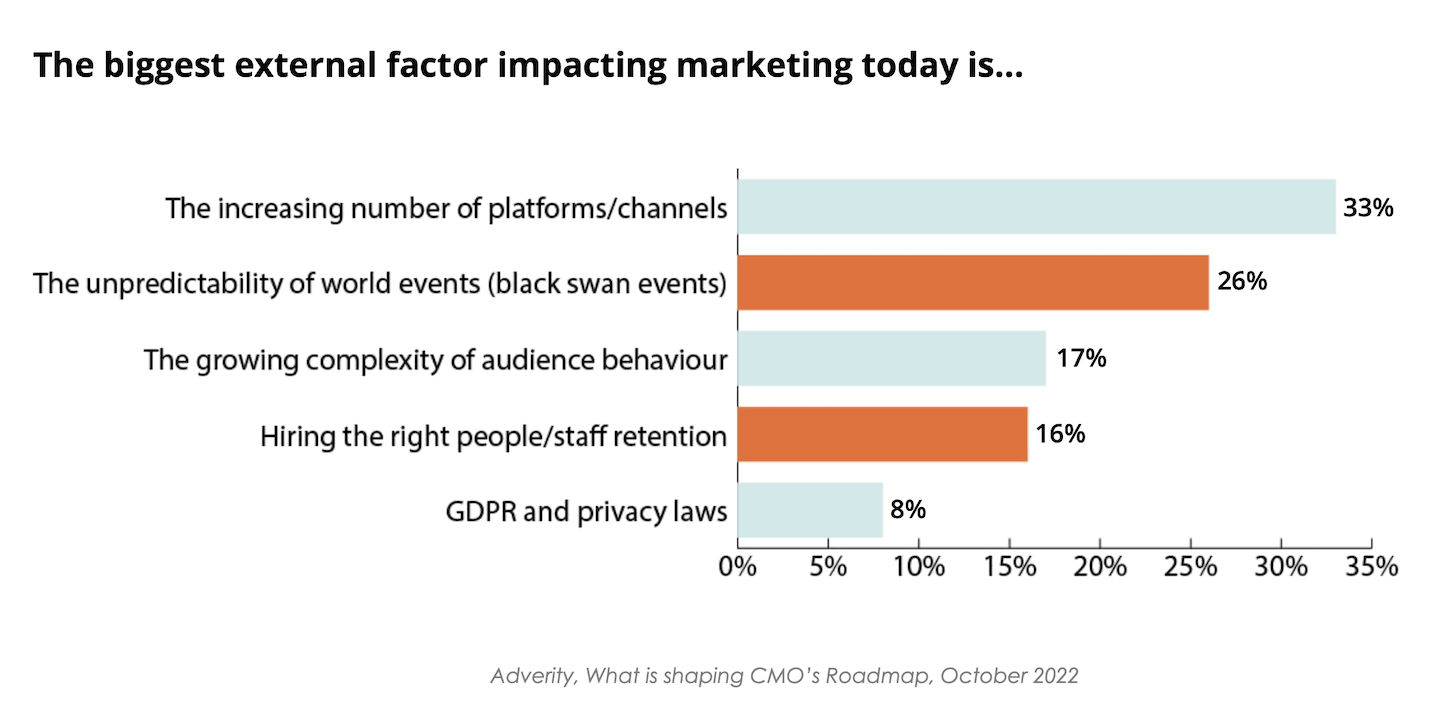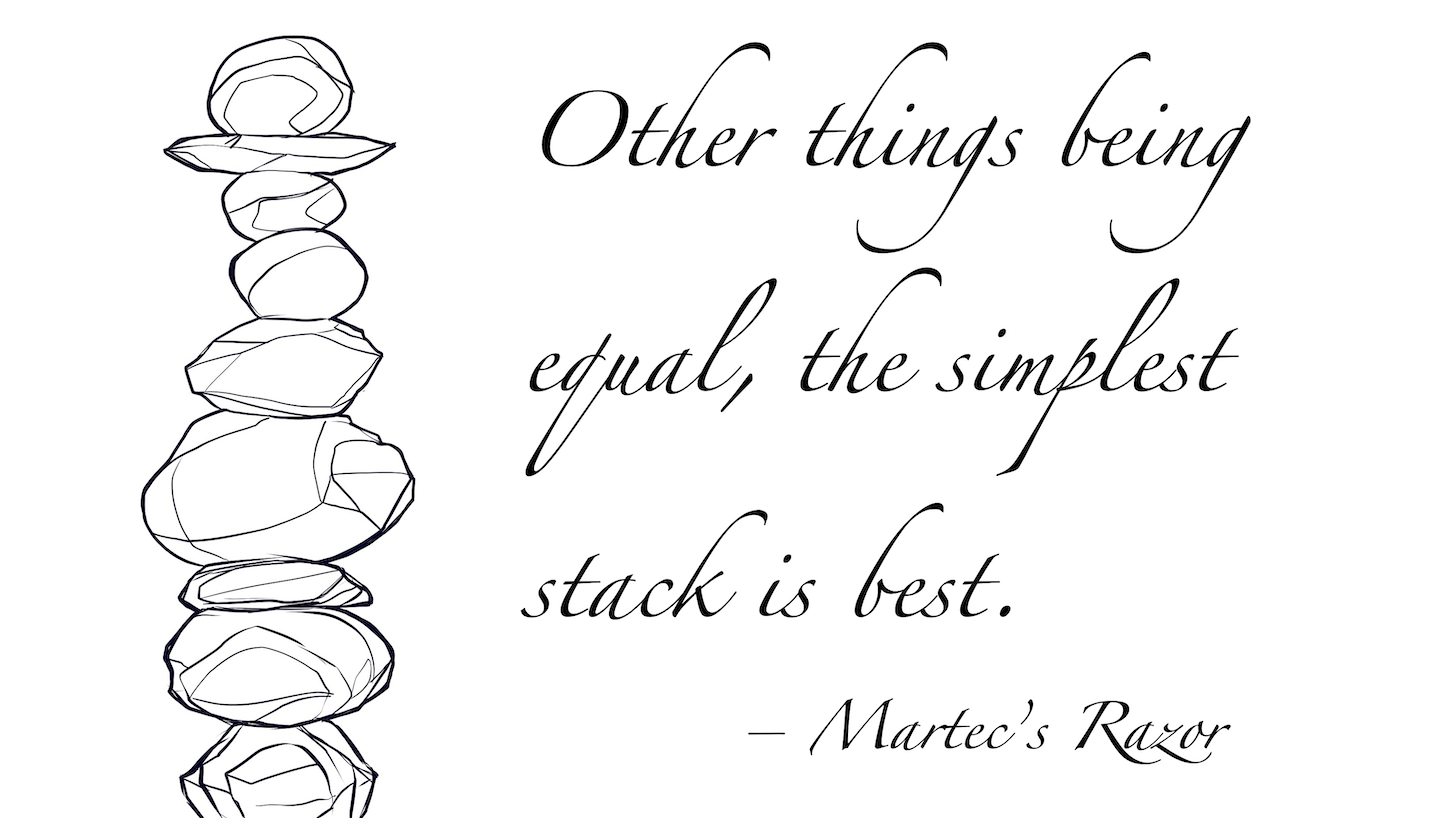
At many companies — but not all — their martech stack has become too complex.
Aside from the anecdotal evidence that I frequently hear on LinkedIn and Twitter threads, Gartner’s most recent Marketing Technology Survey frames the problem quantitatively: on average, the 324 enterprise marketing technology leaders they surveyed reported that only 42% of their martech capabilities are being used.
That’s down from 58% utilization in 2020.
You only need two points to draw a line, and this line is headed in the wrong direction.

I’ll put aside my usual rant about martech stack utilization being a misguided metric and just take this at face value. Whatever these respondents thought they meant by utilization, the fact is that most of them think it’s less than half of what it should be. And they think it’s dropped significantly over the past two years.
That can’t be good.
Now, it’s understandable how this could be trending in the wrong direction. The pandemic motivated an enormous investment in digital transformation for companies, adding a ton of new technologies in all corners of their tech stacks. But especially in marketing. Just take the 3 big martech innovation themes that I predicted for 2022 — all of which seem to be on-track, I’ll humbly note. These encompass a ton of new tools and tactics that have expanded the scope of martech operations at many companies.
Recalling Martec’s Law — technology changes faster than organizations do — we shouldn’t be surprised that all this accelerated pull-forward of new martech would be difficult for marketing teams to absorb quickly. But the added pandemic gifts of The Great Resignation and quiet quitting have exacerbated this challenge even more.
So is the answer for everyone to cut their martech stacks down by 58%?
For some companies, yes. They’ve got way more tech than they’re ready to productively use. They should simplify and focus.
Given the economic belt-tightening that many marketing teams are likely to face in 2023, it’s certainly a good time to review your stack and shed any tools that aren’t adding meaningful value. That might not be because of flaws with those tools, but constraints in your capacity to productively harness them, at least at this moment. Either way, if you’re not getting impactful outcomes from them, they’re ballast.
As Simple as Possible, But No Simpler
But I want to caution against swinging that pendulum too far.
Martech is complex, especially at organizations that are bigger than a small business. This generally isn’t the fault of martech vendors, even if it might make you feel better to blame them sometimes. It’s a function of the complexity inherent in our environment today. Digital everything, digital everywhere has exploded complexity.
Reading a recent report from data platform provider Adverity, What Is Shaping the CMO’s Roadmap?, this chart of “external factors impacting marketing” stood out to me:

The increasing number of platforms/channels = increased complexity.
The unpredictability of world events (black swan events) = increased complexity.
The growing complexity of audience behavior = increased complexity (it’s in the label!).
GDPR and privacy laws = increased complexity.
Hiring the right people/staff retention? Increased complexity from the increasing variety of skills that we’re seeking to address the complexities above. But if we’re not successful at this difficult task, our martech organizational maturity can actually drop instead of grow — at a time when we most need that growth.
All these things are “complex” in the sense that they don’t just have a ton of complicated moving parts. They’re complex in the sense that there’s a ton of interaction effects between them.
Most martech products are actually striving to reduce — or at least help manage – this complexity.
This is an important point because simplifying your martech stack does not simplify the external environment. Simplifying your martech stack might still be a great idea for a bunch of legitimate reasons, many of which boil down to martech organizational maturity: if you’re not ready to extract more value from a more complex stack, then the complexity of your stack is doing more harm than good.
Balancing Martech Simplicity & Martech Complexity

Occam’s Razor — other things being equal, the simplest explanation is usually correct — is a nugget of wisdom adaptable to so many things. Strategy: the simpler the better to provide decision-making clarity. Prioritization: do fewer things well. Customer experience: simpler is almost always easier and more delightful.
This truism certainly applies to martech too.
Martec’s Razor: other things being equal, the simplest stack is best.
But other things aren’t always equal. Connecting siloed marketing and sales data and activities generally increases complexity — more moving parts, more entangled. But for the sake of increasing the efficiency of the business and the continuity of customer interactions across a broader set of touchpoints, that increased complexity can be worth it.
The same applies to adapting to changing customer preferences, experimenting with emerging technologies, and developing new organizational capital by encouraging teams to reach beyond the old ways of doing things. All of these things add complexity to martech operations, intermingling the old and the new. But that’s essential to growth.
The balance of martech leadership is to be continually simplifying while steadily developing your organization’s capacity to manage greater complexity in scenarios in which it can add value.
Aligning Stack Complexity to Martech Maturity
This brings me to the diagram at the top of this post, which I’ll redraw here:

A complex martech stack is not inherently good or bad. It’s good or bad in the context of the martech organizational maturity of the business running it.
A complex stack in a mature martech organization, which has thoughtfully architected it, integrated it properly into their environment, and created the right enablement and governance to help teams properly leverage it, can be an amazingly powerful asset.
That exact same stack, in the hands of an organization with less martech maturity, is a recipe for disaster.
It’s okay if your organization is still early in its journey of developing your martech maturity. Most companies are probably in the left half of the above chart at this point. Developing solid martech maturity takes time. But if you let the complexity of your stack get ahead of your maturity, it will likely slow down your progress instead of accelerating it.
Brian Halligan, HubSpot’s co-founder and executive chairman, has often said, “Companies are more likely to die of overeating than starvation. They tend to do too many things.” This absolutely applies to martech capabilities.
Keep the complexity of your stack in check with your organization’s martech maturity.
And when in doubt, remember this:



